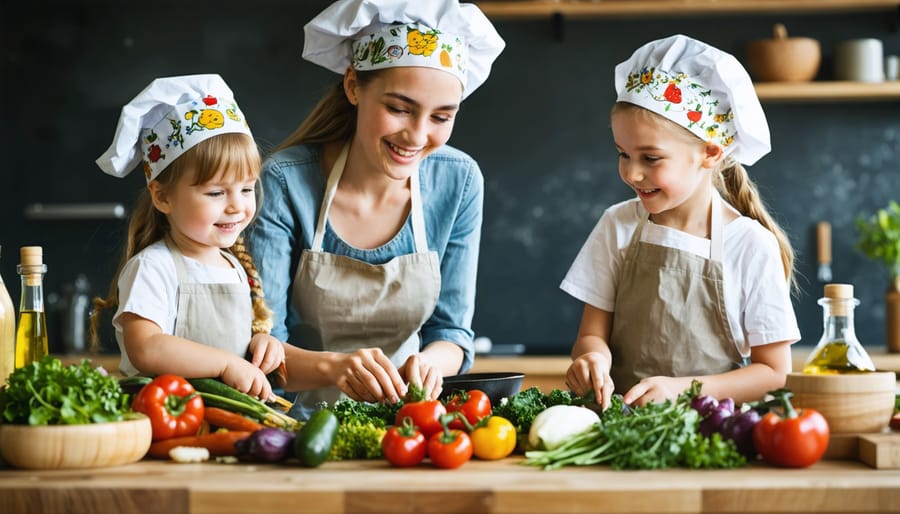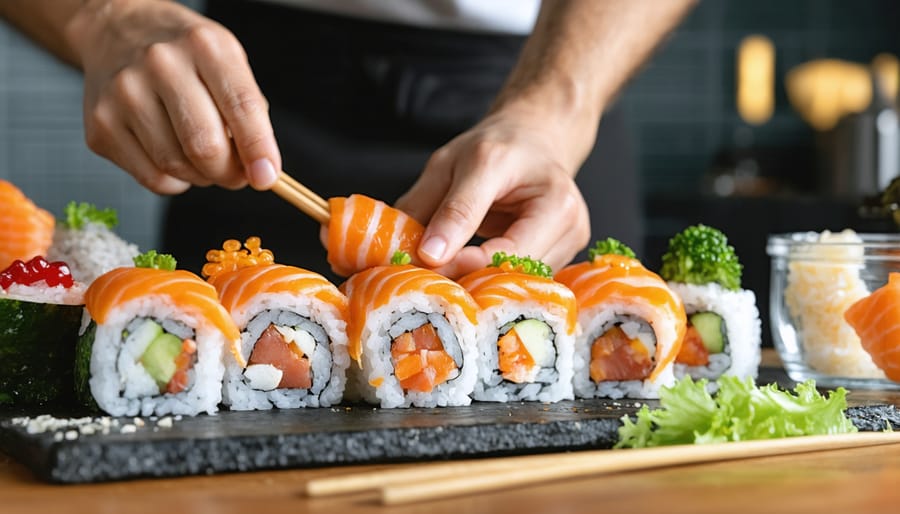
Transform your kitchen into a gateway of culinary adventures where every meal becomes an unforgettable story. Imagine recreating your grandmother’s secret recipe while your children knead dough beside you, or exploring vibrant Thai street food flavors from the comfort of your home. These aren’t just meals – they’re doorways to cultural discovery, family bonding, and sensory exploration that create lasting memories.
Today’s families crave more than just sustenance; they hunger for experiences that connect them to traditions, cultures, and each other. Whether it’s turning pizza night into an Italian cooking lesson, hosting a Japanese tea ceremony, or exploring the ancient spice routes through your spice cabinet, unique culinary experiences offer a perfect blend of education, entertainment, and nourishment.
The beauty of creating distinctive food experiences lies in their accessibility – you don’t need a professional kitchen or exotic ingredients to start this journey. With creativity, curiosity, and basic pantry staples, every meal can become an opportunity for discovery and connection. From blind taste tests with familiar ingredients to themed dinner parties that transport your family across continents, these culinary adventures await right in your own kitchen.
Let’s explore how to transform ordinary mealtimes into extraordinary memories that nourish both body and soul.
Creating Your Family’s Culinary Adventure Space
Kitchen Safety Made Fun
Turning your kitchen into a kid-friendly cooking zone doesn’t mean sacrificing fun for safety. Start by creating a “chef’s station” for your little ones – a dedicated workspace at a comfortable height where they can safely participate. I learned this trick when my daughter insisted on helping with Sunday pancakes!
Make safety engaging by turning it into a game. Create a “Kitchen Safety Superhero” checklist where kids earn stars for washing hands, wearing aprons, and following basic safety rules. For younger children, designate “safe zones” with colorful tape on the floor, keeping them at a safe distance from hot surfaces and sharp objects.
Introduce age-appropriate tools like plastic measuring cups, child-safe knives, and mixing bowls with non-slip bases. My personal favorite is having kids wear chef hats with safety rules decorated on them – it makes them feel professional while keeping important reminders visible.
Remember to model safe behavior yourself and praise their careful attention to safety guidelines. This positive reinforcement helps build confidence while ensuring everyone stays safe during your culinary adventures.

Essential Tools for Little Hands
Getting your little ones involved in the kitchen starts with having the right tools that are both safe and engaging. My daughter’s eyes lit up when I first handed her her very own rainbow-colored mixing bowl, and it’s amazing how such simple items can spark a lifelong love of cooking.
Start with child-sized tools that actually work (not just toys): silicone spatulas with shorter handles, plastic measuring cups in bright colors, and lightweight mixing bowls with non-slip bases are perfect for small hands. A step stool with safety rails is essential – we lovingly call ours the “chef’s platform” in our kitchen.
Consider investing in nylon knives specially designed for children; they’ll cut fruits and soft vegetables but are safe for little fingers. Rolling pins sized for small hands and cookie cutters in fun shapes make baking sessions extra special. Don’t forget colorful aprons and child-sized oven mitts – they’re not just cute but help children feel like real chefs.
Remember, the best tools are those that make your child feel capable and independent while keeping safety in mind.
Global Flavors, Family Stories
Around the World in Your Kitchen
Ready to transform your kitchen into a passport to global flavors? Exploring different cultures through cooking is one of the most delightful ways to bring the world to your family table. Let me share three simple yet authentic recipes that have become favorites in my own kitchen.
First up is a Japanese-inspired Teriyaki Chicken Bowl that my kids absolutely adore. Simply marinate chicken pieces in store-bought teriyaki sauce, ginger, and garlic for 30 minutes. Stir-fry with colorful vegetables, serve over steamed rice, and watch your little ones dive in with chopsticks (or forks – no judgment here!).
For a taste of the Mediterranean, try our family-friendly Greek Pita Pockets. Stuff warm pita bread with crispy lettuce, diced tomatoes, and cucumber. Add grilled chicken or chickpeas, and top with a dollop of tzatziki sauce. It’s hands-on food that creates instant smiles.
My personal favorite is Mexican Street Corn Pasta – a fusion dish that brings together the best of two worlds. Toss cooked pasta with grilled corn kernels, crumbled cotija cheese (or feta), a squeeze of lime, and a light sprinkle of chili powder. Even picky eaters can’t resist this creamy, slightly tangy comfort food.
Remember, the joy isn’t just in the eating – it’s in the stories you share about each dish’s origin and the memories you create together in the kitchen.

Cultural Stories Through Food
Every recipe tells a story, and sharing these tales with our children creates magical moments in the kitchen. I remember how my grandmother would tell me about her childhood in Italy while teaching me to make fresh pasta, making those simple ingredients come alive with history and meaning.
Turn your next cooking session into a cultural adventure by exploring the origins of your favorite dishes. When making tacos, share stories about the ancient Aztecs who first wrapped their meals in corn tortillas. While preparing stir-fry, explain how wok cooking has been bringing Chinese families together for centuries. These stories make cooking more than just following a recipe – they’re windows into different worlds.
Create a special “passport” notebook where your kids can collect recipes and stories from different cultures. Encourage them to interview family members, friends, and neighbors about their traditional dishes. My daughter recently learned about her friend’s Korean grandmother’s kimchi recipe, complete with a heartwarming story about how it helped her stay connected to home when she first moved to America.
Make it interactive by having your children draw pictures of ingredients or write down new words they learn in different languages. When possible, connect with local cultural communities through food festivals or cooking classes. These experiences help children understand that behind every dish is a rich tapestry of human experience, tradition, and love passed down through generations.
Making Memories in the Kitchen
Special Occasion Cooking Rituals
There’s something magical about gathering in the kitchen during special occasions, where cherished family cooking traditions come alive. I still remember the joy of helping my grandmother prepare her signature Christmas cookies, each sprinkle and frosting swirl telling a story of generations past.
Creating your own special occasion cooking rituals doesn’t require elaborate planning – it’s about consistency and heart. Start by choosing one signature dish for each celebration. Maybe it’s heart-shaped pancakes for Valentine’s Day or a traditional family recipe for birthdays. Get the whole family involved by assigning age-appropriate tasks, from measuring ingredients to decorating the final creation.
Document these moments by taking photos or creating a family recipe journal. Consider starting a tradition where each family member contributes a new recipe during holiday gatherings. My family loves our annual Thanksgiving prep day, where we gather the day before to bake pies and share stories.
Make the experience multi-sensory by playing themed music, using special holiday-only cooking tools, or wearing matching aprons. These small touches create lasting memories and give children something to look forward to year after year. Remember, the most meaningful traditions often start with simple ideas and grow more special with each passing celebration.
Documentary Your Delicious Journey
Creating a family cookbook isn’t just about preserving recipes – it’s about capturing the heart and soul of your culinary journey. Start by setting up a dedicated camera or phone spot in your kitchen for easy photo-taking during cooking sessions. Take pictures not just of finished dishes, but of tiny hands kneading dough, grandmother’s weathered fingers crimping pie crusts, and the inevitable flour-covered faces.
Consider starting a cooking journal where you jot down not just ingredients and methods, but the stories behind each dish. Was it Aunt Maria’s secret pasta sauce that sparked a family debate? Or maybe it’s the chocolate chip cookies that always mark the beginning of winter break? These details matter just as much as measurements and temperatures.
Get tech-savvy with your documentation by creating a family cooking vlog or Instagram account. Let each family member take turns being the “chef on camera” while others film. You might be surprised at how natural your little ones become at explaining their cooking process!
Don’t forget to record the sounds of your kitchen – the sizzle of onions hitting hot oil, the cheerful chaos of holiday baking, or the gentle humming of grandma as she stirs the soup. These audio snippets, when paired with photos and recipes, create a rich, multi-sensory memory archive that future generations will treasure.
Beyond the Kitchen

Garden-to-Table Adventures
There’s something magical about planting a tiny seed and watching it transform into your dinner. I discovered this joy last spring when I started my first kitchen garden, and it completely changed my perspective on understanding food sources. Even a small windowsill herb garden can become your gateway to more mindful cooking and eating.
Start with easy-to-grow herbs like basil, mint, and parsley. These kitchen staples thrive in containers and provide instant satisfaction when you snip fresh leaves for your cooking. For those with outdoor space, cherry tomatoes and leafy greens are wonderful beginner-friendly options that kids especially love to help grow and harvest.
The experience of growing your own ingredients creates a deeper connection with your food and seasons. There’s an undeniable pride in serving a salad featuring lettuce you’ve nurtured from seed, or garnishing a pasta dish with basil from your windowsill. Plus, the flavors are incomparable – nothing beats the taste of a sun-warmed tomato picked moments before it hits your plate.
Consider joining a community garden if space is limited. These shared spaces often offer valuable knowledge exchange and the chance to learn from experienced gardeners while growing your own food.
Food Market Exploration
Transform your regular grocery shopping into an exciting culinary adventure! I used to rush through the aisles with my shopping list, but now I make it a point to explore each section with fresh eyes. Start in the produce department, where you can discover seasonal vegetables you’ve never tried before. My daughter recently spotted purple cauliflower, which sparked a wonderful conversation about colorful vegetables and nutrition.
International food aisles are treasure troves of cultural discovery. Bring your family along and challenge everyone to pick one unfamiliar ingredient to research and cook with. Local farmers’ markets add another layer of education, offering opportunities to talk directly with producers about their growing methods and recipe suggestions.
Make it interactive by creating a market scavenger hunt for your kids – have them find fruits from different continents or ingredients in rainbow colors. Take photos of interesting finds, and create a digital cookbook of market-inspired recipes. Remember to engage with vendors, ask questions, and learn the stories behind specialty products. These market explorations often become the foundation for memorable family cooking adventures.
As we wrap up our culinary journey together, it’s important to remember that the magic of cooking lies not just in the dishes we create, but in the moments we share and the traditions we build. Every time you gather in the kitchen with your loved ones, you’re creating more than just meals – you’re crafting memories that will last a lifetime.
Think back to those special moments in your own childhood: the aroma of grandma’s cookies wafting through the house, or the first time you successfully helped prepare a family dinner. These experiences shape us and create bonds that strengthen over time. Now, you have the opportunity to create these same magical moments for your own family.
Starting your own culinary traditions doesn’t require professional expertise or fancy equipment. It begins with simple steps: choosing a regular cooking night, involving everyone in meal planning, or creating a family recipe book. Even kitchen mishaps become cherished stories that you’ll laugh about for years to come.
Remember that every family’s culinary journey is unique. Whether you’re teaching your children basic cooking skills, exploring recipes from your heritage, or experimenting with new cuisines together, you’re building a legacy of love, learning, and connection through food.
So tonight, invite your loved ones into the kitchen. Turn on some music, roll up your sleeves, and start creating your own delicious memories. The dishes you make together might feed you for a day, but the traditions you establish will nourish your family’s soul for generations to come.



